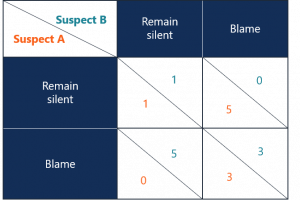What is Game Theory?
23rd November 2019
← Back
Game Theory is a mathematical discipline developed by one of the most influential figures in computer science, John von Neumann. Simply put, it is the study of strategies of rational decision makers in games. From that description alone it may not be immediately obvious why that game theory is an influential field, or why it’s even of interest to anyone. The answer to that question lies in the fact that game theory enables us to make predictions about how people will behave in games. The word “game” can be misleading, because the field isn’t limited to conventional games but applies to all kinds of interactions between rational decision makers. The predictions which game theory helps to create can be used by a “player” in a game to get an advantage, or by the people who make the games; for example policy makers who want to create incentives for people to act in ways that are beneficial to everyone.
Games can be divided into two categories: zero-sum and non-zero sum. A zero-sum game is a game in which one players gain is the other player’s loss. Most conventional “games” which people play for fun are zero-sum games, such as tennis, chess and rock, paper, scissors.
A key concept in game theory is the Nash Equilibrium, named after its originator, John Nash, an incredibly influential mathematician who was portrayed by Russell Crowe in the 2001 film A Beautiful Mind which was based on his biography. A Nash equilibrium is a situation in a game where neither player can gain anything by changing their strategy.
Perhaps the most famous game to have come out of game theory is known as the Prisoner’s Dilemma. Imagine two prisoners have been arrested for armed robbery. The police don’t have enough evidence to convict either of them so they interrogate each of them and try to get them to betray their collaborator in return for a leniency. If both prisoners stay silent they’ll each get one year in prison on a lesser charge. If one prisoner betrays his partner and the other stays silent then the one who betrayed will get off free while the other will get 5 years in prison. If both prisoners betray each other then they’ll each get 3 years. Below is a payoff matrix:

The best strategy for an individual is to betray, because regardless of what their partner does they can only do better by having betrayed. Perhaps the fact which makes the game most interesting, and the reason game theorists have pondered over it for decades, is that although the best strategy for an individual is to betray, both players would be better off if they both remained silent than if they both betrayed each other.
From 2007 to 2009 there was a television game show in the UK called Golden Balls which had a final round which was essentially a prisoner’s dilemma. This made for some very gripping viewing, including the following famous clip.
If each player can only do better by betraying, why would anyone ever do otherwise? Why didn’t the final round of Golden Balls always result in both players betraying each other? The answer comes down to external factors outside the immediate game itself. If a human were to play a game of the prisoner’s dilemma against a computer then you could be quite sure they would choose to betray. In the aforementioned Golden Balls example, Steven said that if he didn’t split (i.e. not betray) then he’d be lynched by the audience. By choosing to split he was acting rationally in a way that goes beyond the scope of the game. We can see a similar effect in a version of the prisoner’s dilemma game called the iterated prisoner’s dilemma, in which opponents play multiple games together. In this game betraying every time is no longer the best strategy, because your action in one round has an effect on your opponents actions in the following rounds.
The effects of game theory aren’t just limited to humans; the field also has been incredibly influential in biology. In 1973 biologist John Maynard Smith formalised a central concept in evolutionary game theory called the evolutionarily stable strategy (ESS). An ESS is simply a Nash Equilibrium that is evolutionarily stable in Natural Selection. In other words, it is a strategy, or set of strategies, which cannot be invaded by alternative strategies. This isn’t, of course, to say that animals are consciously adopting strategies, but simply that the animals or organisms which behave in a way that is evolutionarily beneficial have a greater chance of surviving and reproducing, causing the genes responsible for this behaviour to proliferate.
Charles Darwin was troubled by the presence of altruism in humans and other species. If his theory of evolution by natural selection were true then how could it have produced creatures who act in ways that benefit others at a cost to themselves? In some cases the answer is that the recipients of the altruism are the organism’s relatives who carry the same genes. In other cases, the creatures are playing some version of the iterated prisoner’s dilemma. By acting with kindness to another member of its own species an individual can increase the chances of that kindness being reciprocated in the future if the two individuals meet again.
From games, to game shows, to evolution, Game Theory is a field which continues to help us understand more about how the world works.
Recent Blog Posts

What will the day be in X days?
10th May 2025
In the past I’ve been interested in how to mentally calculate the weekday of any date (if you’re interested, more on this at the end!), but recently I was thinking about a similar — and more straightforward — problem: what will the day be in X days? This may sound like a difficult problem — one that requires a pen… Continue reading »

How to improve your Google PageSpeed score with Webp images
21st August 2021
If you're still serving images in long-time standard formats such as JPEG and PNG then a Google PageSpeed Insights analysis of your site will identify an opportunity to improve your page loading times by serving images in "next-gen" formats. There are several so-called "next-gen" image formats which offer superior compression to JPEG and PNG but in this post we will… Continue reading »